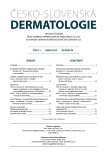-
Medical journals
- Career
Multiple Vulgar Warts Caused by a High-Risk HPV 16 in an HIV Positive Immunodeficient Patient
Authors: M. Part; D. Švecová
Authors‘ workplace: Dermatovenerologická klinika LF UK a UNB Bratislava-Staré Mesto, prednosta prof. MUDr. Mária Šimaljaková, PhD.
Published in: Čes-slov Derm, 90, 2015, No. 1, p. 20-24
Category: Case interpretation
Overview
HPV infections (Human Papilloma Virus) are the most common infections of the skin and mucous membranes. Some of them can be classified as sexually transmitted infections with the highest incidence in the younger sexually active population. Fully functional immune system is able to deal with the high-risk virus infection in some cases. In immunodeficient individuals HPV infection can present with different clinical picture and torpid course. The authors present a case of 48-year-old HIV-positive patient with numerous papular lesions on his face. Histopathologic examination confirmed the diagnosis of vulgar warts. Molecular genetic method (PCR) demonstrated the presence of highly oncogenic HPV 16, which is not considered as an etiological agent in verrucae vulgares. HPV 16 may lead to dysplastic changes localized on the cervix, vagina, vulva, penis, anus and oropharynx. Due to HIV infection, the patient was treated with triple combination of antivirals (lamivudine, etravirine, darunavir), with 30/µl of CD4 T lymphocyte count initially. Antiretroviral treatment was given continuously during topical treatment of HPV infection. Topical application of imiquimod was effective in eradicating of all skin lesions within 1 month of therapy. After one-year follow up, the patient was without any cutaneous manifestations of HPV infection.
Keywords:
vulgar warts – HPV infection – HIV - immunodeficiency – imiquimod
Sources
1. ARANY, I., TYRING, S. K. Systemic immunosuppresion by HIV infection influences HPV transcription and thus local immune responses in condyloma acuminatum. Int. J. STD AIDS, 1998, 5, p. 268–271.
2. BARBOSA, P. Plantar verruca and HIV infection. Clin. Podiatr. Med. Surg., 1998, 15 2, p. 317–327.
3. BERNARD, H., BURK, R. D., CHEN, Z. et al. Classification of papillomaviruses (PVs) based on 189 PV types and proposal of taxonomic amendments. Virology, 2010, 401, p. 70–79.
4. DELIGEOROGLOU, D., GIANNOULI, A. et al. HPV infection: immunological aspects and their utility in future therapy. Infect. Dis. Obstet. Gynecol., 2013, 2013 : 540850. doi: 10.1155/2013/540850.
5. FATHI, R., TSOUKAS, M. M. Genital warts and other HPV infections: Established and novel therapies. Clin. Dermatol., 2014, 32, p. 299–306.
6. GIANNAKI, M., KAKOUROU, T., THEODORIDOU, M. et al. Human papillomavirus (HPV) genotyping of cutaneous warts in Greek children. Pediatr. Dermatol., 2013, 30, 6, p. 730–735.
7. HENGGE, U. R. Papillomaviruserkrankungen. Hautarzt, 2004, 55, p. 841–854.
8. HENGGE, U. R. Spektrum der HPV-Infektion in der Dermatologie: Besonderheiten bei Organtransplantieren und HIV-Patienten. In Hengge, U. R. HPV-Infektionen und Neoplasien der Haut. UNI-MED, 2003, Bremen.
9. HENGGE, U. R., MOTA, R., MARINI, A. Häufige und seltene dermatologische Erkrankungen bei HIV-Patienten. Hautartz, 2006, 57, p. 975–987.
10. HILLE, J. J., WEBSTER-CYRIAQUE, J. et al. Mechanisms of expression of HHV8, EBV and HPV in selected HIV-associated oral lesions. Oral Dis., 2002, 8, 2, p. 161–168.
11. HOWLEY, P. M., LOWY, D. R. Papillomaviruses and their replication. In Knipe, D. M., Howley, P. M. Fields virology, 4th end. Lippincott Williams and Wilkins, Philadelphia, 2001, p. 2197–2229.
12. CHOW, L. T., BROKER, T. R. Human papillomavirus infections: warts or cancer? Cold Spring Harb Perspect Biol., 2013, 5, 7, doi: 10.1101/cshperspect.a012997.
13. LUU, H., AMIRIAN, E. S., CHAN, W. et al. CD4+ cell count and HIV load as predictors of size of anal warts over time in HIV-infected women. J. Infect. Dis., 2012, p. 578–585.
14. MEYS, R., GOTCH, F. M., BUNKER, C. B. Human papillomavirus in the era of highly antiretrovirus therapy for human immunodeficiency virus: an immune reconstruction-associated disease? Br. J. Dermatol., 2010, 162, 1, p. 6–11.
15. SALAVEC, M. Virová oněmocnení kuže a sliznic působená herpes simplex viry a lidskými papilomaviry. Čes.-slov. Derm., 2006, 81, 5, p. 249–269.
16. VOJTAŠŠÁK, J. et al. Etiopatogenéza rakoviny krčka maternice. Onkológia (Bratisl.), 2010, 5, 5, p. 278–281.
17. WEISMANOVÁ, E. et al. HPV a krčok maternice: genetická podstata malígnej transformácie bunky. Onkológia (Bratisl.), 2008, 3, 6, p. 389–392.
18. WHITAKER, J. M., PALEFSKY, J. M., DE COSTA, M. et al. Human papilloma virus type HPV 69 identified in a clinically aggressive plantar verruca from an HIV-positive patient. J. Am. Podiatr. Med. Assoc., 2009, 99, 1, p. 8–12.
19. WOLFF, K., JOHNSON, R. A. et al. Fitzpatrick’s Color Atlas and Synopsis of Clinical Dermatology. 7th edition. Mc Graw Hill Education, USA, 2013, p. 692–698. ISBN 978-0-07-179302-5.
Labels
Dermatology & STDs Paediatric dermatology & STDs
Article was published inCzech-Slovak Dermatology

2015 Issue 1
Most read in this issue- Acarodermatitis – Dermatitis Caused by Mites
- Clonal Melanocytic Naevi
- Multiple Vulgar Warts Caused by a High-Risk HPV 16 in an HIV Positive Immunodeficient Patient
- Therapeutic Education in Dermatology
Login#ADS_BOTTOM_SCRIPTS#Forgotten passwordEnter the email address that you registered with. We will send you instructions on how to set a new password.
- Career

